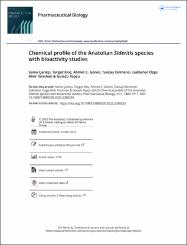| dc.contributor.author | Çarıkçı, Sema | |
| dc.contributor.author | Kılıç, Turgut | |
| dc.contributor.author | Gören, Ahmet C. | |
| dc.contributor.author | Dirmenci, Tuncay | |
| dc.contributor.author | Toraman, Gülbahar Özge Alim | |
| dc.contributor.author | Topçu, Gülaçtı | |
| dc.date.accessioned | 2024-08-15T11:36:08Z | |
| dc.date.available | 2024-08-15T11:36:08Z | |
| dc.date.issued | 2023 | en_US |
| dc.identifier.issn | 1388-0209 / 1744-5116 | |
| dc.identifier.uri | https://doi.org/10.1080/13880209.2023.2280253 | |
| dc.identifier.uri | https://hdl.handle.net/20.500.12462/15020 | |
| dc.description | Kılıç, Turgut (Balikesir Author) | en_US |
| dc.description.abstract | Context: The genus Sideritis L. (Lamiaceae) is represented by 46 species in Turkey with an 79%
endemism ratio, 42 of 46 belonging to the section Empodoclia.
Objective: In this review article, Sideritis species growing in Turkey have been evaluated for
phytochemical constituents and biological activities.
Methods: The data for the isolates, components and extracts of the Anatolian Sideritis species and
their bioactivity studies were retrieved from the main databases WoS, Scopus and PubMed from 1975
until 31 December 2022.
Results: In this review article, terpenoids, flavonoids, phenolics and other secondary metabolites
isolated from Turkish Sideritis species were reported. Anatolian Sideritis species, which primarily consist
of monoterpenes and sesquiterpenes, were studied in detail. Sideritis plants are represented by 46
species in Turkey, and 25 of them were investigated for their diterpenoids through isolation or LC–MS
studies. Most of the diterpenoids of Turkish Sideritis species have ent-kaurene skeleton, among them
linearol, siderol, 7-epicandicandiol and sideridiol were found to be the main compounds. Exceptionally,
labdane, pimarane and beyerene diterpenoids were only found in a few species. For phenolics and
flavonoids, only 12 species were investigated until now, and they were found to be rich in
phenylethanoid glycosides and flavonoid glycosides. In terms of activity, most of the species were
tested for antioxidant activity, followed by antimicrobial and anti-ulcer/anti-inflammatory activities.
Their cytotoxic, enzyme inhibitory, antinociceptive and antistress activities were less frequently studied.
Conclusions: Sideritis species should be considered promising therapeutic agents in the treatment of upper
respiratory tract and ulcer/inflammatory diseases. | en_US |
| dc.description.sponsorship | Istanbul University 12.2017/45
Bezmialem Vakif University | en_US |
| dc.language.iso | eng | en_US |
| dc.publisher | Taylor & Francis Ltd | en_US |
| dc.relation.isversionof | 10.1080/13880209.2023.2280253 | en_US |
| dc.rights | info:eu-repo/semantics/openAccess | en_US |
| dc.subject | Secondary Metabolites | en_US |
| dc.subject | Essential Oils | en_US |
| dc.subject | Iridoids | en_US |
| dc.subject | Diterpenoids | en_US |
| dc.subject | Phenolics | en_US |
| dc.subject | Flavonoids | en_US |
| dc.subject | Glycosides | en_US |
| dc.title | Chemical profile of the Anatolian Sideritis species with bioactivity studies | en_US |
| dc.type | review | en_US |
| dc.relation.journal | Pharmaceutical Biology | en_US |
| dc.contributor.department | Necatibey Eğitim Fakültesi | en_US |
| dc.contributor.authorID | 0000-0002-6842-3160 | en_US |
| dc.identifier.volume | 61 | en_US |
| dc.identifier.issue | 1 | en_US |
| dc.identifier.startpage | 1484 | en_US |
| dc.identifier.endpage | 1511 | en_US |
| dc.relation.tubitak | "info:eu-repo/grantAgreement/TUBITAK/TBAG-105T430" | |
| dc.relation.tubitak | "info:eu-repo/grantAgreement/TUBITAK/TBAG-113Z710" | |
| dc.relation.tubitak | "info:eu-repo/grantAgreement/TUBITAK/T-434/08032004" | |
| dc.relation.publicationcategory | Makale - Uluslararası Hakemli Dergi - Kurum Öğretim Elemanı | en_US |


















